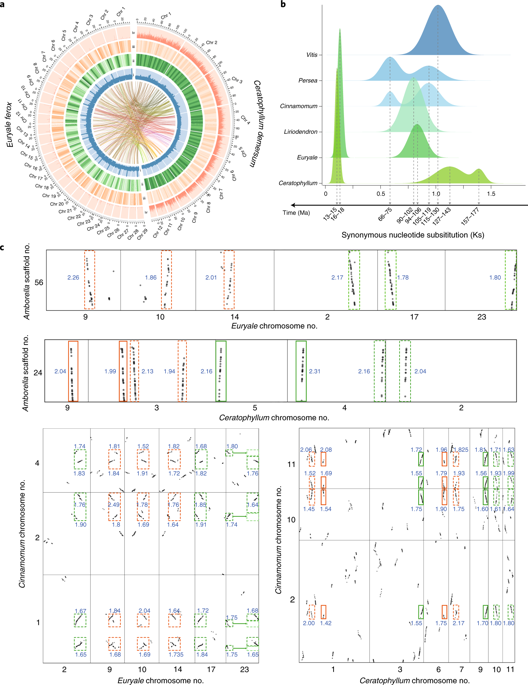Nature Plants ( IF 18.0 ) Pub Date : 2020-02-24 , DOI: 10.1038/s41477-020-0594-6 Yongzhi Yang 1, 2 , Pengchuan Sun 3 , Leke Lv 1 , Donglei Wang 1 , Dafu Ru 1 , Ying Li 2 , Tao Ma 1 , Lei Zhang 1 , Xingxing Shen 4 , Fanbo Meng 3 , Beibei Jiao 3 , Lanxing Shan 3 , Man Liu 3 , Qingfeng Wang 5 , Zhiji Qin 3 , Zhenxiang Xi 1 , Xiyin Wang 3 , Charles C Davis 6 , Jianquan Liu 1, 2

|
Angiosperms represent one of the most spectacular terrestrial radiations on the planet1, but their early diversification and phylogenetic relationships remain uncertain2,3,4,5. A key reason for this impasse is the paucity of complete genomes representing early-diverging angiosperms. Here, we present high-quality, chromosomal-level genome assemblies of two aquatic species—prickly waterlily (Euryale ferox; Nymphaeales) and the rigid hornwort (Ceratophyllum demersum; Ceratophyllales)—and expand the genomic representation for key sectors of the angiosperm tree of life. We identify multiple independent polyploidization events in each of the five major clades (that is, Nymphaeales, magnoliids, monocots, Ceratophyllales and eudicots). Furthermore, our phylogenomic analyses, which spanned multiple datasets and diverse methods, confirm that Amborella and Nymphaeales are successively sister to all other angiosperms. Furthermore, these genomes help to elucidate relationships among the major subclades within Mesangiospermae, which contain about 350,000 species. In particular, the species-poor lineage Ceratophyllales is supported as sister to eudicots, and monocots and magnoliids are placed as successively sister to Ceratophyllales and eudicots. Finally, our analyses indicate that incomplete lineage sorting may account for the incongruent phylogenetic placement of magnoliids between nuclear and plastid genomes.
中文翻译:

多刺睡莲和刚性金鱼草基因组揭示早期被子植物进化
被子植物代表了地球上最壮观的陆地辐射之一1,但它们的早期多样化和系统发育关系仍然不确定2,3,4,5。造成这种僵局的一个关键原因是缺乏代表早期分化被子植物的完整基因组。在这里,我们展示了两种水生物种——多刺睡莲(Euryale ferox;Nymphaeales)和刚性金角藻(Ceratophyllum demersum)的高质量、染色体水平的基因组组装; Ceratophyllales)——并扩大被子植物生命树关键部分的基因组表示。我们在五个主要进化枝(即睡莲目、木兰科、单子叶植物、Ceratophyllales 和真双子叶植物)中的每一个中确定了多个独立的多倍化事件。此外,我们跨越多个数据集和不同方法的系统发育分析证实,Amborella和睡莲目依次是所有其他被子植物的姐妹。此外,这些基因组有助于阐明包含约 350,000 个物种的被子植物内主要分支之间的关系。尤其是,物种贫乏的木兰目被支持为真双子叶植物的姐妹,而单子叶植物和木兰科则被列为金鱼草目和双子叶植物的姐妹。最后,我们的分析表明,不完整的谱系分类可能是木兰科植物核和质体基因组之间不一致的系统发育位置的原因。


























 京公网安备 11010802027423号
京公网安备 11010802027423号